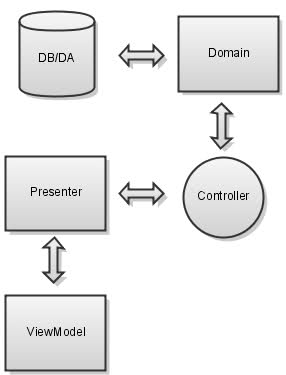At the moment, i got quite badly fashioned view model.
Classes looks like this=>
public class AccountActionsForm
{
public Reader Reader { get; set; }
//something...
}
Problem is that Reader type comes from domain model (violation of SRP).
Basically, i'm looking for design tips (i.e. is it a good idea to split view model to inputs/outputs?) how to make my view model friction-less and developer friendly (i.e. - mapping should work automatically using controller base class)?
I'm aware of AutoMapper framework and i'm likely going to use it.
So, once more - what are common gotchas when trying to create proper view model? How to structure it? How mapping is done when there's a multiple domain object input necessary?
I'm confused about cases when view needs data from more than 1 aggregate root. I'm creating app which has entities like Library, Reader, BibliographicRecord etc.
In my case - at domain level, it makes no sense to group all those 3 types into LibraryReaderThatHasOrderedSomeBooks or whatnot, but view that should display list about ordered books for specific reader in specific library needs them all.
So - it seems fine to create view OrderedBooksList with OrderedBooksListModel view model underneath that holds LibraryOutput, ReaderOutput and BibliographicRecordOutput view models. Or even better - OrderedBooksListModel view model, that leverages flattening technique and has props like ReaderFirstName, LibraryName etc.
But that leads to mapping problems because there are more than one input.
It's not 1:1 relation anymore where i kick in one aggregate root only.
Does that mean my domain model is kind a wrong?
And what about view model fields that live purely on UI layer (i.e. enum that indicates checked tab)?
Is this what everyone does in such a cases?
FooBarViewData fbvd = new FooBarViewData();
fbvd.Foo = new Foo(){ A = "aaa"};
fbvd.Bar = new Bar(){ B = "bbb"};
return View(fbvd);
I'm not willing to do this=>
var fbvd = new FooBarViewData();
fbvd.FooOutput = _mapper.Map<Foo,FooOutput>(new Foo(){ A = "aaa"});
fbvd.BarOutput = _mapper.Map<Bar,BarOutput>(new Bar(){ B = "bbb"});
return View(fbvd);
Seems like a lot of writing. :)
Reading this at the moment. And this.
Ok. I thought about this issue a lot and yeah - adding another abstraction layer seems like a solution =>
So - in my mind this already works, now it's time for some toying.
ty Jimmy

